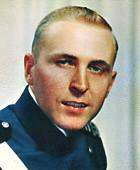
Charlie Diver
Dropping 10,000 and 15,000 Pound Bombs in Vietnam
During late1969 and early 1970, I was a navigator on the only operational C-130 crew to be dropping 10,000- and 15,000-pound bombs in Vietnam. Our crew was in the 772 TAS of the 463rd TAW. As I understand it, the M121 10,000-lb bomb, was developed for the B-36 but never used. Consequently, they had been retained in storage. The idea to drop them from B-52s in Vietnam was circulated, but the cost of putting fins on to stabilize them during the drop proved to be to costly, and that project was dropped. The idea to drop them with a stabilizing parachute out of the back of a C-130 surfaced and became a reality. The program was named Commando Vault.
In late 69, crews of the 772 TAS would load one or two M121s in a special C-130. The aircraft was deemed special because the rails, the part of the 130 that the pallets slid in/on for loading and unloading, were specially aligned to make sure one or both bombs would go smoothly out of the back of the cargo door and not get hung up during exit. The M121 had a steel casing about 1.5 inches thick, and upon impact/detonation it would destroy anything in a large radius around the point of impact. Initially, the bombs were used for clearing the jungle for immediately usable helicopter landing zones; success would be measured in two ways: firstly, the location of the impact in relation to where the impact was requested and, secondly, the number of helicopters that could land there immediately. After a drop, normal calls were a PI, Point of Impact (exactly where it was wanted), and that will be a two shipper and, with a bit of chainsaw, a three shipper--meaning two helicopters could land immediately, and with a little bit of chainsaw action a third helicopter could be on the ground at the same time the first two were offloading.
When dropping the M121, the C-130 flew at an altitude of 5-6000 feet above ground and was guided to a drop point by ground radar--similar to a Ground Controlled Approach, except maintaining an altitude. The air position drop point was determined by taking an offset from the Point of Impact and applying the forward travel of the bomb from release and the offset from the wind effect from ground to drop altitude. As navigator, I would determine the offset and call it into the ground radar, which would apply it to the PI, and the pilot would fly the headings given by the radar at the predetermined airspeed/altitude. At the drop point, the Loadmaster would release the bomb; hopefully it would sail out the back of the aircraft and not get hung up, and the rest would be history.
Initially, the bombs were used for helicopter landing zones, but later other targets were designated, and many of these targets would have a secondary explosion associated with our bomb(s). We went through the M-121s too quickly for my money, and in early 1970, we were using the BLU-82, a newly-manufactured 15,000 pound bomb. This was more like a propane tank, thin skinned, but with half again the explosive mixture-of propane and TNT--I believe. It was thought the added explosive would make for bigger landing zones and areas of destruction, but without the thick steel casing that the M-121 had, the BLU-82 did not perform as well as the smaller bomb in clearing the thick jungle. The C-130 could carry two BLU-82s from a weight perspective, but we never did carry two for a drop, due to center of gravity considerations.
The accuracy of the Commando Vault program was extremely good, with mountain tops a specialty, where 5-10 meters one way or another would mean the drop was completely unsuccessful.
Eventually, in the spring of 1970 other crews from the 29th, 773rd and 774th TASs of the 463rd TAW were checked out in this procedure; so, there was at least one bomb-qualified crew in country at any given time.